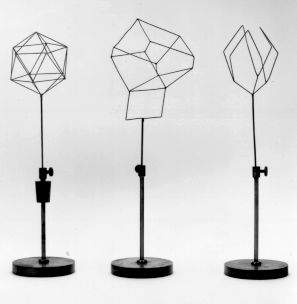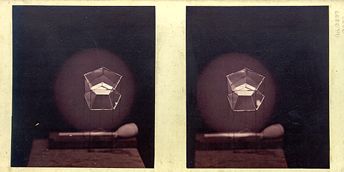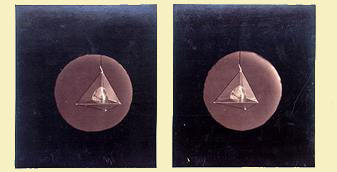Joseph Plateau does many experiments about oil-equilibrium shapes in
the water-alcohol mixture. They are rather involved and later he reproduces
them with thin soap films. The same experiments are then a lot easier
and lead to the same results. Thin soap films are so light that in fact
they "are not subjected to gravity" and take equilibrium shapes, analogous
to those of oil in a water-alcohol mixture. A typical example is the soap
bubble, which has a spherical shape just like the oil sphere in the Plateau
experiment.
To do his experiments, Plateau uses a solution he calls "liquide glycérique".
It is François Donny (1822-1896) who suggests the composition. Some experimenting
leads to the following composition: 3 parts of a watery filtered solution
of Marseille soap and 2 parts of pure glycerine. Plateau mentions that
it is not always simple to obtain the products in the necessary purity
and concentration. When a figure made of thin wire is briefly submerged
in the liquid, thin soap films form between the wires.

Wire figures for the study of soap films
Photo MD.
Museum for the History of Sciences, Ghent
For his research concerning the laws governing the formation of laminar soap films Plateau has some 80 wire figures made. Among them are several that give lovely shapes. After submersion in "liquide glycérique", the rightmost figure shows a shape reminiscent of the calyx of a tulip.
 0
0
Stereo pictures of laminar soap films formed on the wire shapes by Plateau
Photo A.L. Neyt, Ghent, about 1880. Collection J.Plateau, Ghent
Plateau finds the following laws:
1. each wire edge supports one film
2. at a liquid edge no more than 3 films can come together; they then
form angles of 120°
3. the liquid edges that come together in one point are always in the
number of 4 and form angles of 109°28'
The laminar surfaces that are formed in these experiments hardly differ
from what Plateau obtained with oil masses in a water-alcohol mixture.
Moreover, due to interference in the incident light, the soap films show
all the colours. From this Plateau succeeds in calculating the thickness
of the films, and from that the action radius of the molecular forces
that hold together the films.